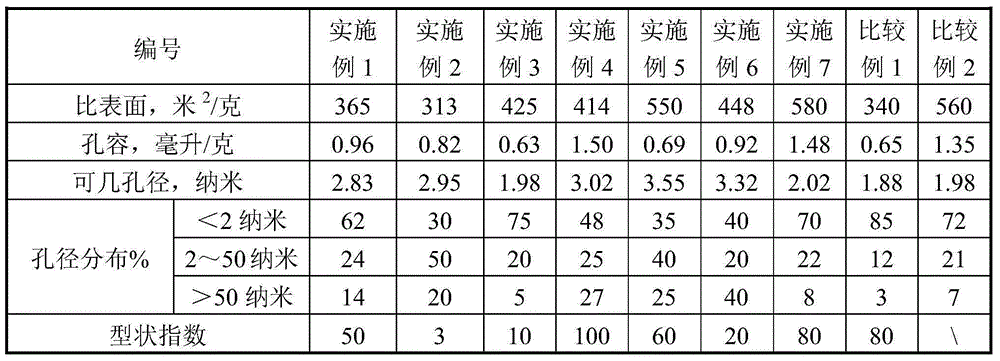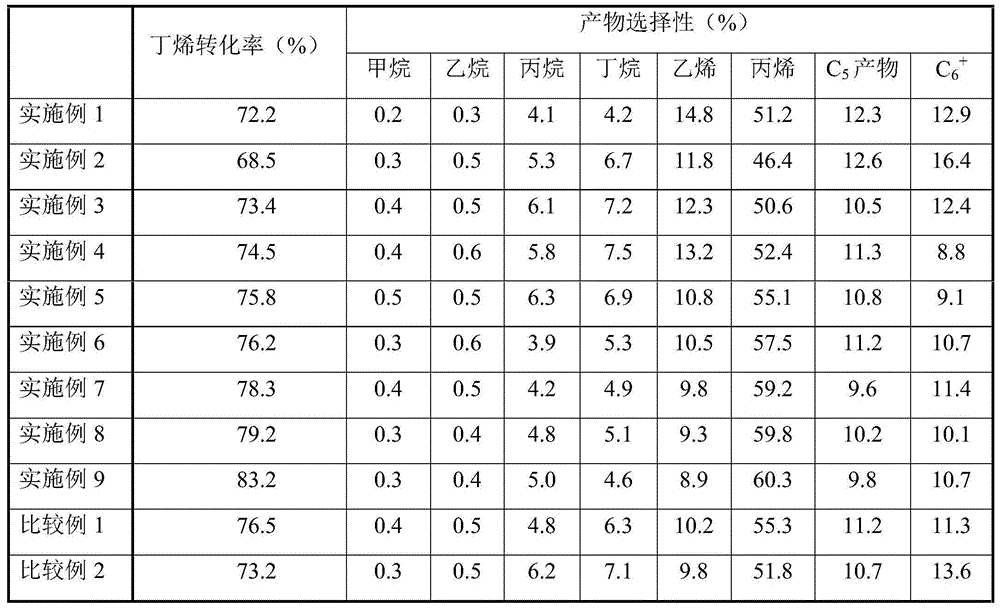Method for producing propylene by catalytic cracking of C4 olefin
A technology for catalytic cracking and carbon tetraolefin, which is applied in the production of bulk chemicals, chemical instruments and methods, and hydrocarbon cracking to produce hydrocarbons. It can solve the problems of poor catalyst stability and low propylene selectivity, and achieve good technical effects.
- Summary
- Abstract
- Description
- Claims
- Application Information
AI Technical Summary
Problems solved by technology
Method used
Image
Examples
Embodiment 1
[0024] With tetrapropylammonium bromide as the template, aluminum nitrate as the aluminum source, and silica sol as the silicon source, the raw materials are first molarally mixed with SiO 2 / Al 2 o 3 =200;OH - / SiO 2 =0.3; R / SiO 2 =0.5;H 2 O / SiO 2 = 40 mixed in a ratio of 40, hydrolyzed completely at room temperature, put into a stainless steel reactor, controlled the growth direction of molecular sieve crystals under hydrothermal conditions, and crystallized at 100°C for 60 hours to obtain the silicon-aluminum molar ratio SiO 2 / Al 2 o 3 NaZSM-5 molecular sieve with a shape index of 200 and a shape index of 50.
[0025] Take by weighing 40 grams of NaZSM-5 molecular sieves prepared above, 25 grams of silica sol (SiO 2 40% by weight), add water and knead, extrude into a mold with a diameter of 1.5 mm, dry, place in an oven at 80°C for 8 hours, and bake in a muffle furnace at 600°C for 6 hours to remove the template agent. Stir in 5% sodium carbonate aqueous solution...
Embodiment 2
[0036] Tetrapropylammonium hydroxide is used as a template, aluminum sulfate is used as an aluminum source, water glass is used as a silicon source, and raw materials are molar ratios of SiO 2 / Al 2 o 3 =500;OH - / SiO 2 =0.05; R / SiO 2 =1.5;H 2 O / SiO 2 = 10 ratio mixing, using the method described in Example 1, crystallized at 80 ° C for 100 hours, to obtain the silicon-aluminum molar ratio SiO 2 / Al 2 o 3 NaZSM-5 molecular sieve with a shape index of 500 and 3.
[0037] Take by weighing 30 grams of NaZSM-5 molecular sieves prepared above, 38 grams of silica sol (SiO 2 weight percent content 40%) and 15 grams of aluminum oxide, add water and knead, with a diameter of 1.5 mm mold extruded molding, dry, placed in 100 ℃ oven for 5 hours, in 600 ℃ muffle furnace roasting 4 hours, Remove templating agent. Stir in 10% sodium hydroxide aqueous solution at 50°C for 3 hours, dry, and bake at 550°C for 4 hours. Exchange three times in 10% ammonium chloride solution at 85°C, d...
Embodiment 3
[0040] Tetraethylammonium chloride is used as a template, sodium aluminate is used as an aluminum source, and tetraethyl orthosilicate is used as a silicon source. The raw material is molar ratio of SiO 2 / Al 2 o 3 =800;OH - / SiO 2 = 1.5; R / SiO 2 =0.02;H 2 O / SiO 2 = 30 ratio mixing, using the method described in Example 1, crystallization at 120 ° C for 50 hours, to obtain the silicon aluminum molar ratio SiO 2 / Al 2 o 3 NaZSM-5 molecular sieve with a shape index of 800 and a shape index of 10.
[0041] Take by weighing 10 grams of NaZSM-5 molecular sieves prepared above, 32 grams of silica sol (SiO 2 40% by weight) and 10 grams of aluminum phosphate, mixed with water, extruded into a mold with a diameter of 1.5 mm, dried, placed in a 120°C oven for 8 hours, and roasted in a 500°C muffle furnace for 8 hours. Remove templating agent. Stir in 5% sodium hydroxide aqueous solution at 60°C for 4 hours, dry, and bake at 550°C for 4 hours. Exchange three times in 10% ammo...
PUM
 Login to View More
Login to View More Abstract
Description
Claims
Application Information
 Login to View More
Login to View More - R&D
- Intellectual Property
- Life Sciences
- Materials
- Tech Scout
- Unparalleled Data Quality
- Higher Quality Content
- 60% Fewer Hallucinations
Browse by: Latest US Patents, China's latest patents, Technical Efficacy Thesaurus, Application Domain, Technology Topic, Popular Technical Reports.
© 2025 PatSnap. All rights reserved.Legal|Privacy policy|Modern Slavery Act Transparency Statement|Sitemap|About US| Contact US: help@patsnap.com



